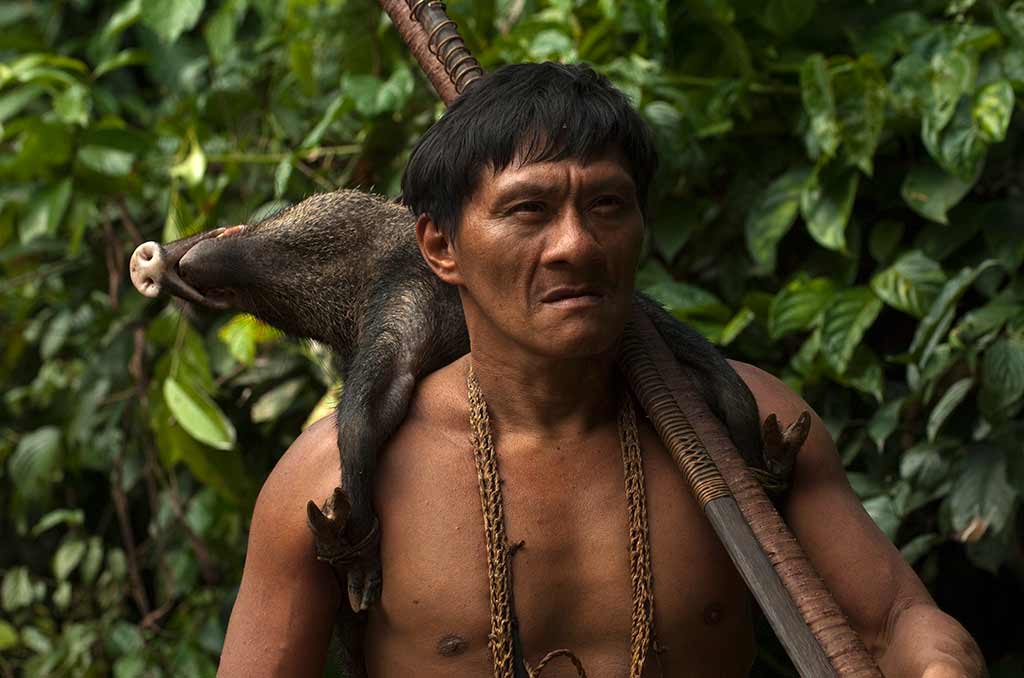Yesterday we received news, from friends in the Yasuni National Park and UNESCO Biosphere Reserve, that a Huaorani Indian had been speared to death by the Tagaeri. Sound familiar? Probably not. Most people, I am sure, have never heard of the three key words in the opening paragraph above, namely, Yasuni, Huaorani and Tagaeri.
The Yasuni has (at least in many taxa) been scientifically documented to harbour more species per unit area than anywhere else on Earth. A bold statement but it is truly a place that needs to be seen to be believed. Situated in the east of Ecuador, Yasuni is a lowland, primary, Amazonian rainforest. A place I first had a relationship with nearly 30 years ago and have been in love with ever since. It’s where I first met Reneé, where we later married, where we have God children and where I have been driven to help protect, through imagery and story telling since we published our first book on the region back in 1995.
In many cases there is a ratio that works that what we have in Yasuni in one hectare, there is the equivalent in the entire USA and Canada combined. Firstly remember that a hectare is a mere 100 x 100 meters – say the floor of a football stadium or a city block perhaps. What I mean by this is that, for example, in 1 Yasuni hectare there have been recorded more than 650 tree species yet only about 560 in the whole of USA and Canada. 1 Yasuni hectare has 100,000 insect species, about the same as USA and Canada. Or, for example in 1 Yasuni hectare were found 87 amphibian species, more than 3 times the whole of Western Europe. The park itself has some 600 bird species while 925 or so are reported from the USA and Canada. You get the idea!
Within the park and biosphere reserve live the Huaorani. An ancient tribe of true forest people ( see my earlier blog , (add the link for the alone in the forest blog) They are incredible in their environment and understand their forest home like no other. They hunt monkeys using a poison-tipped dart, magically puffed from a blow-gun in a single breath. They run barefoot into a herd of wild and dangerous peccaries, to spear one with an ironwood spear and carry it home, tied like a backpack, to feed the family.
When the missionaries arrived in the 1950’s and saved their savage souls, the Huaorani were missionarized, paving the way for the Amazon to be opened up without the fear of being attacked by the new ‘friendlies’. Oil companies, loggers (mostly illegal) and colonizers poured into the forest using the rivers and newly constructed oil roads as conduits to push ever deeper into the interior and reap their rewards. Or, put another way, set the Yasuni on its path of destruction. On finding missionaries one Huaorani leader, named Taga, was astute enough to visualize the grave changes that lay ahead. He fled, deeper into the forest, with his followers. Followers of Taga are known, in the Huaorani language, as Tagaeri. They continue to live their traditional lifestyle in an ‘uncontacted’ state of voluntary isolation.

We know of the existence of another, similar group, in the same area, also in voluntary isolation, the Taromenane. It seems they are of somewhat different roots as their language differs widely from that of the Huaorani. One Huao friend of mine described that during a chance encounter he had with the Taromenane that “They open their mouths but no words come out.” Translated it means that he could not understand them when they spoke!
In today’s Yasuni the pressures continue. Roads are the single biggest curse to the forest. Roads always bring people! There is not one oil company, foreign or national, that is using ‘Best Practice’ within the National Park and biosphere reserve, i.e. not one that is using the ‘Offshore/Inland’ model of roadless technology to mine the oil. The latest threat is that new oil concessions are being dished out to Chinese state-owned oil companies to repay the megadebt that Ecuador now owes their country. This surely signals the end of the-beginning-of-the-end and takes us closer to the end-of-the-end. The most biodiverse place on Earth swallowed by human greed on my watch? I’m just glad I’ve got no kids to answer to!
As for the Tagaeri and Taromenane, little do they know that they are soon to see their first Chinaman. What they do know already is that they are being pressured from all sides. Unscrupulous loggers, it is reported, have even paid the ‘tame’ Huaorani to hunt them down and massacre them in their homes to clear the way. They feel pressure from encroaching oil camps, logging camps, colonizers and even, to a lesser extent, eco-tourists.
Would you defend your right of abode if you were being systematically squeezed off your territory or land, I ask? Many would say yes. So, I ask the question again. Sound familiar? Yep!
Pete Oxford



Comments (0)